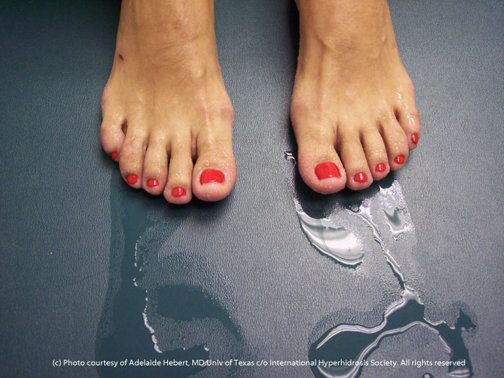Targeted Dermatology Treatments for Hyperhydrosis of Hands and Feet: Reliable Solutions
Targeted Dermatology Treatments for Hyperhydrosis of Hands and Feet: Reliable Solutions
Blog Article
Understanding the Source of Excessive Sweating and Its Effect On Every Day Life
While it is typically comprehended as a physiological response to manage body temperature level, the triggers for too much sweating can vary widely amongst individuals, incorporating not just physical elements but emotional and also psychological components. By delving into the origin triggers of hyperhidrosis and exploring its complex impacts, a much deeper understanding of this prevalent issue can be gained, losing light on the complexities that individuals grappling with too much sweating navigate on a day-to-day basis.
Physiology of Sweat Glands
The guideline of sweat production, an important physiological procedure, is mainly controlled by the task of sweat glands dispersed across the human body. Gland are categorized right into two major types: eccrine and apocrine glands. Eccrine glands are one of the most many and are found in virtually all locations of the body. They play an important duty in thermoregulation by secreting a watery liquid onto the skin's surface, which aids and evaporates cool down the body down. On the other hand, apocrine glands are focused in areas abundant in hair follicles, such as the armpits and groin, and their secretions are thicker and milklike in appearance.
When the body temperature climbs, either due to physical task, heats, or emotional stress and anxiety, the nerves activates the sweat glands to produce sweat. This sweat is composed primarily of water and electrolytes like salt and chloride. The process of sweat production is important for preserving the body's inner temperature within a narrow, optimum array, highlighting the crucial function sweat glands play in human physiology.
Triggers for Excessive Sweating
In recognizing the origin of extreme sweating, it is critical to identify the triggers that can result in this physical action. Too much sweating, likewise called hyperhidrosis, can be motivated by numerous factors, both physiological and environmental. One common trigger is emotional anxiety or anxiousness, which can promote the body's sweat glands to create more sweat than is required for cooling. Physical effort, heats, and spicy foods are additionally known to trigger excessive sweating in individuals prone to this problem. Moreover, particular clinical problems like hyperthyroidism, menopause, or diabetic issues can add to too much sweating too.
Furthermore, drugs such as some antidepressants, opioids, and specific supplements can also work as triggers for hyperhidrosis. Comprehending these triggers is important in taking care of extreme sweating efficiently - Sweaty hands treatment. By identifying and resolving the particular triggers that motivate extreme sweating in a specific, doctor can create personalized therapy strategies to minimize this problem and enhance the person's lifestyle
Medical Issue Associated
Related to too much sweating are various clinical problems that can intensify this physical response. One common problem is hyperhidrosis, a problem characterized by unusually increased sweating that surpasses the body's thermoregulatory requirements. This can show up in focal areas like the palms, soles, underarms, or face, influencing a person's quality of life because of social shame and discomfort.
Additionally, endocrine disorders such as hyperthyroidism, diabetes, and menopausal warm flashes can likewise lead to extreme sweating. Hyperthyroidism triggers an overproduction of thyroid hormones, increasing metabolic rate and activating sweating.
Furthermore, infections like endocarditis, consumption, and hiv have actually been associated with evening sweats, a typical symptom recognized to interrupt rest and impact general health. These medical problems highlight the varied variety of underlying factors that can add to excessive sweating, necessitating detailed analysis and monitoring by health care specialists.
Psychological and Psychological Variables
:max_bytes(150000):strip_icc()/sweaty-palms-palmar-hyperhidrosis-4691320-10512b2d428846059753b76df6dc74c2.png)
Influence On Social Interactions
Too much sweating can have profound effects on an individual's capacity to engage conveniently in social interactions. The noticeable signs of sweat discolorations or wet patches on clothing can lead to shame and self-consciousness, creating individuals to withdraw from social scenarios. This withdrawal can impact partnerships, limit social activities, and prevent personal and expert growth.

Moreover, the anxiety and self-confidence issues coming from extreme sweating can influence interaction and social skills. Individuals may struggle to focus on discussions, take part in team tasks, or share themselves confidently. This can important source cause sensations of seclusion and isolation, as social links come to be testing to keep.
Verdict

While it is commonly understood as a physical feedback to manage body temperature, the triggers for excessive sweating can vary commonly among people, incorporating not only physical elements but additionally psychological and mental elements. By diving right into the origin triggers of hyperhidrosis and exploring its complex results, a deeper understanding of this prevalent problem can be acquired, shedding light on the intricacies that individuals grappling with too much sweating browse on a daily basis.
Physical physical effort, high temperature levels, and spicy foods are also known to cause extreme sweating in individuals susceptible to this condition. By recognizing and attending to the specific triggers that motivate excessive sweating in a specific, health care providers can create customized therapy plans to ease this condition and boost the individual's top quality of life.
Excessive sweating can have extensive effects on a person's capacity to engage pleasantly in social interactions.
Report this page